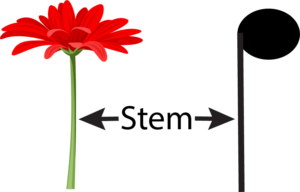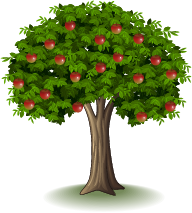Y1. Lesson 23. Transcribe stick to staff notation
Prior learning: Note stems
Duration: 30 minutes
Materials:
Keywords: Beat, rhythm, singing, chanting, partners, rhymes, circle games.
Difficulty: ![]()
Prepare
Present
Stick to staff notation
Practise
Note stems, so & mi
 Melodic development
Melodic development
![]() Students discover another song for their repertoire.
Students discover another song for their repertoire.
- Sing the song using a neutral syllable to the class.
- Ask the class to repeat the first line after you.
- Continue with the following lines in the same fashion, with students copying you.
- When secure, teach the first line; students should repeat after you.
- Repeat for the following lines.
- Ask the class to sing with you.
- Students should sing and clap the beat.
 Questions
Questions
- Where can you find a star?
- When can you see a star?
- Are stars near or far?
- Is our sun a star?
 Rhythmic development
Rhythmic development
![]() Students discover that so & mi joins to the rhythm time names.
Students discover that so & mi joins to the rhythm time names.
 Questions
Questions
- What do we mean by rhythm?
- Can solfa connect to rhythm?
- Students are seated in front of the board.
- Draw the time names of ta and ti-ti on the board of a simple so and mi song, such as See-Saw.
- Ask the class what these time names mean [the rhythm]
- Write so and mi underneath each time name and ask the class what they mean.
- Point to each time name in turn as the class sings the song.
- Repeat, this time pointing to so and mi.
- Teach that the time names and the solfa are connected.
- Ask a volunteer to come forward and point to the time names.
- Repeat with another volunteer to point and sing the solfa.
 Creative movement
Creative movement
![]() Students sing and perform the movements in this popular circle game.
Students sing and perform the movements in this popular circle game.
- This song has many verses and several different ways to interpret the movements.
- The words 'allemande' and 'do-si-do' are used to replace the words 'circle to the left/right' in some versions, and this is what Dr James Cuskelly is using in this example.
- Students are in a circle with partners with their right hands raised and touching that of their partner.
- They rotate on the spot and sing the song (here shown as 'Allemande, old brass wagon')
- For the second verse, students cross their arms and rotate around their partner, singing 'Do-si-do'.
Other verses/variations
Circle to the left, old brass wagon (3 times) You're the one, my darling.
Circle to the right, old brass wagon (3 times) You're the one, my darling.
Everybody in, old brass wagon (3 times) You're the one, my darling.
Swing, oh swing, old brass wagon (3 times) You're the one, my darling.
Do-si-do, old brass wagon (3 times) You're the one, my darling.
Into the centre, old brass wagon (3 times) You're the one, my darling.
Allemande left, old brass wagon (3 times) You're the one, my darling.
Promenade home, old brass wagon (3 times) You're the one, my darling.
 Listening
Listening
![]() Students must correctly identify songs from the audio player,
Students must correctly identify songs from the audio player,
- The audio player on the left contains the rhythm patterns of four well-known classroom songs.
- Divide the class into two teams. The winning team will be the one that correctly identifies the most songs.
- Play each track in turn and ask the class which song the pattern is from.
- After receiving correct answers, ask the class to recite the song using time names only.
 Visual learning
Visual learning
![]() Students discover how solfa meets rhythm!
Students discover how solfa meets rhythm!
- Project or draw the graphic on the board.
- Explain to students that the time names ta and t-ti are sitting above so and mi - and they want to join together!
- Point to the first staff. Ask students to clap the stick notation and then sing the solfa of so and mi.
- Ask a volunteer what the green arrow means. Is it trying to tell us something?
- Point to the second staff. Ask the class what they can see.
- Teach that the stick notation of ta and ti-ti has joined the solfa of so and mi on the staff.
- Remind students that notes can have a stem, just like a flower has a stem.
- Explain that the time name ta has a single stem, but the time name ti-ti has the stems joined together with a beam!

 Instruments
Instruments
![]() Students use Orff instruments to play a well-known classroom song.
Students use Orff instruments to play a well-known classroom song.
- Divide the class into three groups or as appropriate for the number of instruments available.
- Distribute glockenspiels, xylophones and marimbas (or equivalent classroom instruments).
- Explain to the class that they will discover how to play Apple Tree on their instruments.
- Using a glockenspiel, teach the melody to the group with that instrument, remembering to watch for the correct technique.
- When secure, teach the very simple accompaniments on the xylophone and marimba to the students with those instruments.
- When secure, count in the song, then watch and listen carefully to the results. Give gentle guidance to any student that is having difficulties.
- This song might need more than one learning period to complete successfully.

 Part work
Part work
![]() Students practice staged audiation with a well-known song.
Students practice staged audiation with a well-known song.
- This song is used to great effect in developing students' inner hearing (audiation).
- Students are seated. Hum the melody and ask students to tell you the song's name.
- Students then form a circle.
- Lead the class in singing the song, with students keeping the beat with their feet.
- When the song is finished, tell students that they will sing again, but this time without the 'boom' at the end.
- On the next repeat, decide which words the students will keep in their heads, such as "Sally, go round."
- Keep repeating the song with fewer and fewer words sung at loud until the entire song is carried in students' heads only.
 Assess
Assess
Suggested lessons
Y1. Beat II

Y1. Beat III

Y1. Beat IV

